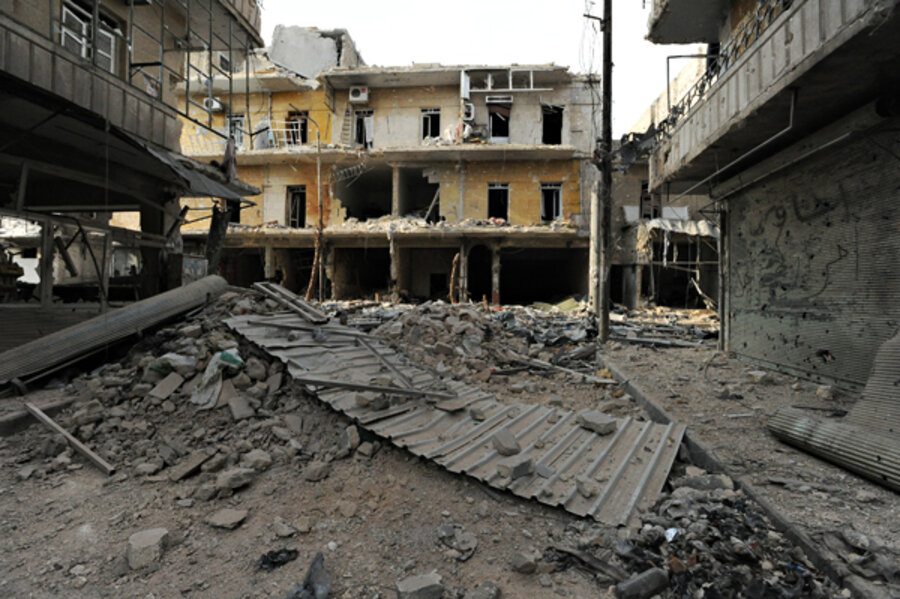Holiday cease-fire in Syria pocked with bullets
Loading...
• A daily summary of global reports on security issues.
Just hours after the Syrian cease-fire took hold, reports of its violation began to emerge. Two previous truces in the 20 month conflict did not last, but there is hope that this most recent cease-fire will provide a long-enough pause in the fighting to begin negotiations to end the conflict.
But both sides have attached caveats to their agreement to a cessation of violence – which has already killed nearly 35,000 people, according to the opposition, and displaced hundreds of thousands – eroding the likelihood that it can hold.
The Syrian Army warned that although it agreed to the cease-fire, it would respond to rebel attacks, while the rebel forces – who lack a unified leadership – gave varying answers about how much they would respect the agreement.
"Syrian armed forces will, however, reserve the right to reply to terrorists attacks, attempts of armed groups to reinforce or resupply, or attempts to infiltrate from neighboring countries," the Army said in a statement, according to BBC.
Col. Ahmed Hijazi, who identified himself as the chief of staff of the Free Syrian Army, the rebels’ primary fighting force, said the rebels wouldn’t agree to a cease-fire because it was skeptical of the regime’s compliance. "The regime is used to treachery and scheming," Colonel Hijazi said, according to the BBC. "It is not to be trusted."
Meanwhile, rebel spokesman Brig. Methqal Husani al-Btaish al-Neemeh laid out conditions for a cessation to fighting: freedom for all prisoners, an end to air strikes, an end to the siege on the city of Homs, and a promise not to use the pause in fighting to re-arm. None of those conditions have been met.
One of the first breaks in the cease-fire seems to have happened near Aleppo, when Syrian government troops fired on anti-government activists attempting to stage a demonstration, The Washington Post reports. Emboldened by the government’s agreement to the cease-fire, Syrians staged similar protests across the country, reminiscent of the large Friday protests that sparked the uprising-turned-civil-war in the first place, but which have largely ceased amid the violence.
The Syrian Observatory for Human Rights said there were “fierce clashes” in northern Idlib province, reporting that fighters with rebel group Jabhat al-Nusra Front, one of the factions that said it would not observe a truce, attacked a Syrian Army checkpoint. The Army retaliated by shelling a nearby village.
Jabhat al-Nusra’s attack highlights one of the key challenges of any agreement in Syria: The Free Syrian Army, the main rebel fighting force, and the Syrian National Council, the political entity that represents many of the anti-regime groups, can only nominally control the many factions of the vast opposition movement. Jabhat al-Nusra is one of the many that the FSA has been unable to bring under its wing.
According to the Post, Mustafa al-Sheik, commander of the FSA’s military council, told Al Jazeera that if the Syrian Army stopped its shelling campaign, the rebels would obey the cease-fire. But later in the interview he seemed to acknowledge he couldn’t make that promise.
“For now, no one can speak for the armed opposition,” Mr. Sheik said. “It only listens to the Syrian will.”
Tony Karon speculates in Time that the true intent of the cease-fire isn’t a pause in fighting – that perhaps even United Nations special envoy to Syria Lakhdar Brahimi, who brokered the agreement, accepts that neither side intended to keep its promise – but to make clear who the parties for a final agreement might be.
The absence of any external monitoring personnel or established protocols for disengagement, much less any enforcement mechanism, is a clear sign that the Eid al-Adha truce plan is largely an effort to have the combatants make a symbolic commitment to the idea of a future political settlement. Having honed his reputation in decades of mediating such intractable conflicts as the civil wars Lebanon and Afghanistan, Brahimi is not so naive as to believe Syria’s can be ended any time soon; instead, he’s establishing lines of communication with all sides, making sure that the Syrian combatants and their foreign sponsors will know where to turn when one or the other is ready to sue for peace. That moment, though, will likely be some time in coming.
“Brahimi is not making the same mistake as his predecessor in the mediator’s role, Kofi Annan, in pretending he can solve the conflict any time soon,” says Joshua Landis, a Syria expert at the University of Oklahoma. “Instead, he’s establishing himself as a go-between, knocking on the doors of all the players inside Syria and outside, looking for the lowest common denominators that can change the dynamic without making optimistic claims. And the fact that he’s got the major actors saying ‘yes’ to a cease-fire even when we all know they mean ‘no’, is a sign that the Syrian parties remain concerned to maintain international backing.”








